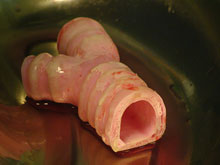First successful transplantation of a synthetic windpipe [UPDATE: BOGUS RESEARCH]
July 11, 2011

Artificial trachea after two days of cell growth (credit: Harvard Bioscience)
The prestigious medical journal The Lancet has retracted two articles co-authored by disgraced thoracic surgeon Paolo Macchiarini, after an investigation by his former institute found him responsible for scientific misconduct. The publications, one a research paper published in 2011 and the other a review published in 2012, were retracted on 7 July and relate to an experimental transplant technique that involved implanting artificial windpipes seeded with stem cells into a patient. The surgery, carried out in three people between 2011 and 2013, failed. — Nature, July 10, 2018
A 36-year-old man has received the world’s first synthetic trachea, made from a synthetic scaffold seeded with his own stem cells, in an operation at the Karolinska University Hospital in Stockholm, Sweden.
Professor Paolo Macchiarini of Karolinska University Hospital and Karolinska Institutet led an international team, including professor Alexander Seifalian from University College London, who designed and built the nanocomposite tracheal scaffold, and Harvard Bioscience, which produced a specifically designed bioreactor used to seed the scaffold with the patient´s own stem cells.
The cells were grown on the scaffold inside the bioreactor for two days before transplantation to the patient. Because the cells used to regenerate the trachea were the patient’s own, there has been no rejection of the transplant and the patient is not taking immunosuppressive drugs.
“The big conceptual breakthrough is that we can move from transplanting organs to manufacturing them for patients,” says David Green, the president of Harvard Bioscience in Holliston, Massachusetts.
Transplantations of tissue-engineered windpipes with synthetic scaffolds in combination with the patient’s own stem cells as a standard procedure means that patients will not have to wait for a suitable donor organ. Patients could benefit from earlier surgery and have a greater chance of cure. This would be of especially great value for children, since the availability of donor tracheas is much lower than for adult patients.
